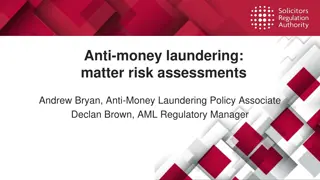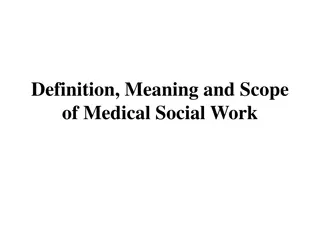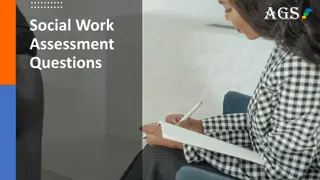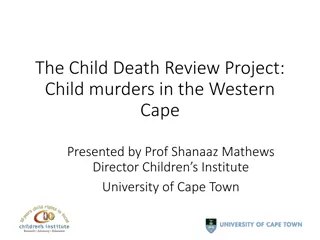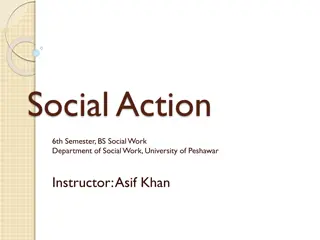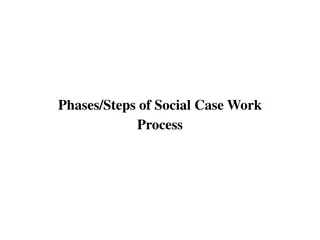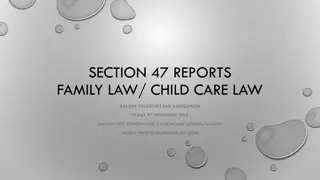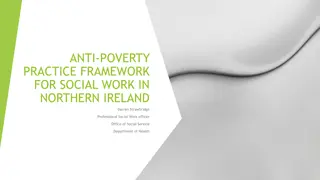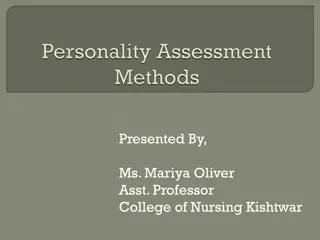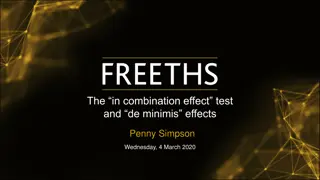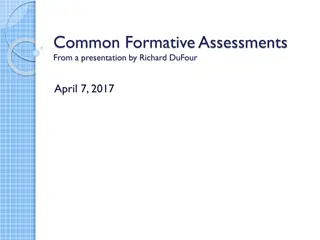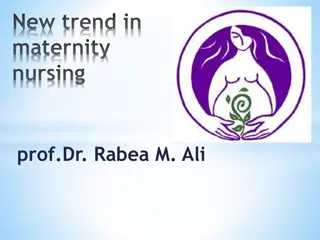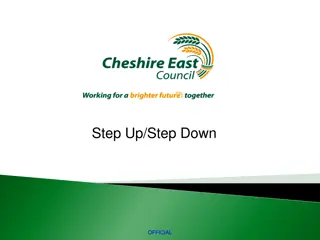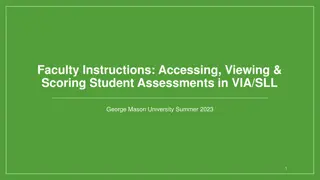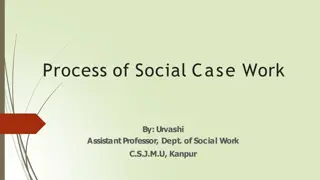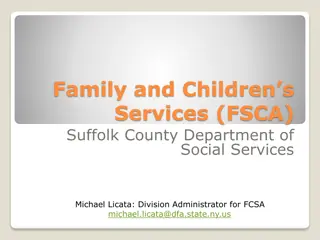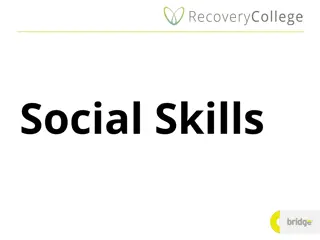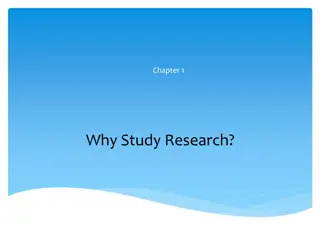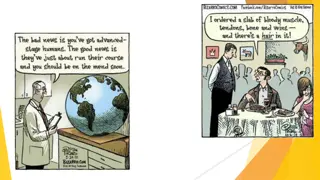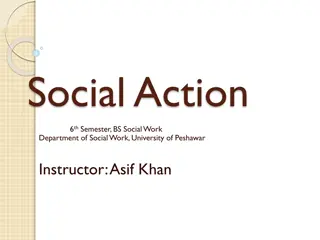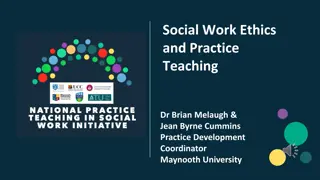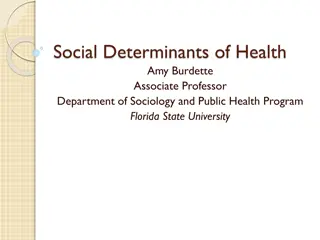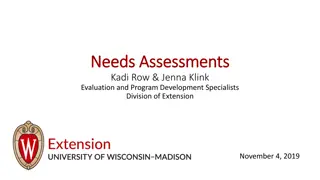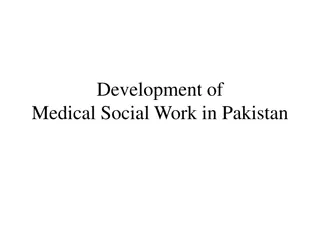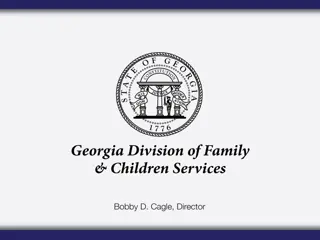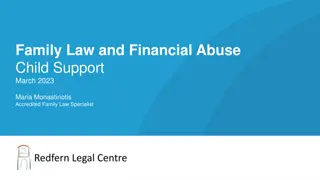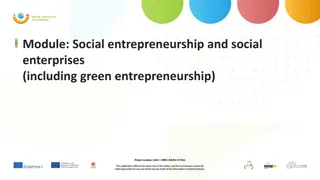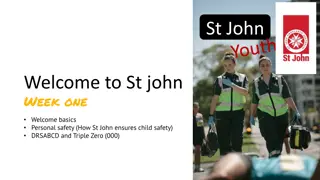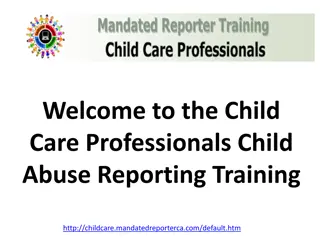Understanding Child and Family Assessments for Social Work
A child and family assessment is crucial in social work to gather information, analyze concerns, and make decisions in the best interests of the child. This process includes referrals, visits to the child, and collaboration with key professionals. The assessment is based on various sources of information, including historical data, home visits, and the child's perspective. Through a structured process, social workers aim to understand and address welfare concerns effectively within specified timelines.
Download Presentation

Please find below an Image/Link to download the presentation.
The content on the website is provided AS IS for your information and personal use only. It may not be sold, licensed, or shared on other websites without obtaining consent from the author. Download presentation by click this link. If you encounter any issues during the download, it is possible that the publisher has removed the file from their server.
E N D
Presentation Transcript
Writing Good Child and Family Assessments Francesca Benvenga Advanced Practitioner
What is a Child and Family Assessment? The process of gathering and analysing sufficient information about a child and their family in order to understand how to help and child and their family in the best interests of the child It is completed in response to concerns being raised about a child s welfare and will help the social worker make decisions about: The nature and impact of the concerns or needs described in the referral and what intervention or support is necessary; Whether the child meets the criteria for ongoing services as a Child in Need . A maximum timescale of 45 working days from the point of referral to completion allows flexibility and individualisation of response, but the speed should be determined by the needs of the particular children and presenting risk. The assessment must include visits to the child.
What is the process? Referral (aka MARF) received into the MASH raising concern about a child s welfare C&F assessments are also used to review a child and family s circumstances in other areas of the service: When a child is subject to CP Plan (completed before every Child Protection Conference) When a child is Looked After (completed before every Child Looked After Review) When there is a significant change in the child or family s circumstances (to consider the impact of those changes on the child and their current plan of intervention) MASH enquiries find that concerns are substantiated and require further investigation Case passed to Assessment team Social Worker to complete a C&F assessment of identified concerns
What should the assessment be based upon? The information contained in the referral; Information gathered and shared via discussions with key relevant professionals and networks (e.g. the child s GP, school, Health Visitor, Children s Centre, etc). Note: Parents / carers will be required to give consent to the information being shared in Child in Need referrals; Any historical information held within the agency; or other local authority; A home visit with the family and children to answer any outstanding questions. With the permission of the parent/carer the child should be seen alone if of sufficient age and understanding, and their bedroom seen. If this permission is not forthcoming, and there are child protection concerns, the relevant safeguarding procedures should be followed in consultation with a manager; The voice of the child which must be captured within the assessment.
Underpinning principles of a good assessment High quality assessments: are child centred; are rooted in child development and informed by evidence; are focused on action and outcomes for children; are holistic in approach, addressing the child s needs within their family and wider community; ensure equality of opportunity; involve children and families; build on strengths as well as identifying difficulties; are integrated in approach; are a continuing process not a single event; lead to action, including the provision and review of services; are transparent and open to challenge
Underpinning principles of a good assessment Social Work assessments must always: analyse the information systematically and understand the child s developmental needs, including whether they are suffering harm; analyse parents and carer s capacity to respond to those needs; analyse the impact and influence of wider family, community and environmental factors; take a systematic approach, drawing on the most up to date research; include contributions from all relevant agencies; be evidence-based; be clearly recorded within the child s social care record;
Status of the Assessment Section 17: A child in need is defined under the Children Act 1989 as a child who is unlikely to reach or maintain a satisfactory level of health or development, or their health and development will be significantly impaired, without the provision of services. In these cases, assessments by a Social Worker are carried out under Section 17 of the Children Act 1989. The purpose of these assessments is to gather evidence about a child s developmental needs and the parents capacity to meet these needs within the context of their wider family and community. This information must be used to inform decisions about the help needed by the child. A child who is disabled is also defined as a child in need.
Status of the Assessment Section 47: If the Social Worker assesses that the child is suffering, or likely to suffer significant harm, then the local authority under Section 47 of the Children Act 1989 is required to make enquiries to decide what action must be taken, with partners, to safeguard and promote the welfare of the child. There may be a need for immediate protection whilst the assessment is carried out. A Strategy Discussion with partner agencies is required in order to discuss and determine the threshold for Section 47 enquiries and assessment (though their agreement is not required for a Section 47 enquiry to proceed within Social Care) Consent for agency checks is not required, but best practice is still to gain this
Process of Assessment Visit to the family parents spoken to about concerns, children spoken to alone, gain consent for agency checks (even if S47) Agency checks sent off consider ALL agencies, not just ones you think are relevant Write up assessment with information gathered At least one further visit to family to further unpick information or explore certain aspects of the assessment, further direct work with the children Once all agency checks received and sufficient information gathered, assessment written including analysis and recommendation and sent for manager for authorisation
The Framework for Assessment (DoH, 2000a)
The Framework for Assessment (DoH, 2000a) The Framework for the Assessment of Children in Need and their Families provides a systematic basis for collecting and analysing information to support professional judgements about how to help children and families in the best interests of the child. Practitioners should use the framework to gain an understanding of: a child s developmental needs; the capacity of parents or care givers to respond appropriately to those needs, including their capacity to keep the child safe from harm; and the impact of wider family and environmental factors on the parents and child.
Childs Developmental Needs
Health Includes growth and development as well as physical and mental wellbeing. The impact of genetic factors and of any impairment needs to be considered. Involves receiving appropriate health care when ill, an adequate and nutritious diet, exercise, immunisations (where appropriate) and developmental checks, dental and optical care and, for older children, appropriate advice and information on issues that have an impact on health, including sex education and substance misuse. Please ensure you gain consent to speak to ALL health professionals (GP, Health Visitor, Midwife, School Nurse, CAMHS, Consultants/Specialists etc) and include their feedback in this section (do not copy and paste)
Health Illness or disability (get names of specialists) Medication (dosage, frequency, review) Pregnancy/birth (consider stress and impact on development) Feeding/weaning GP registration GP/Hospital admissions Immunisations Development checks Midwife Health Visitor School Nurse Sleeping Routine Nappies/Potty training Allergies Dentist Optician Smoking/drinking/drugs (for older children) Weight/diet (where relevant to concerns)
Education Covers all areas of a child s cognitive development which begins from birth. Includes opportunities: For play and interaction with other children; To have access to books; To acquire a range of skills and interests; To experience success and achievement. Involves an adult interested in educational activities, progress and achievements, who takes account of the child s starting point and any special educational needs. Please ensure you gain consent to speak to the child s school/college/nursery/pre-school/education provider and include their feedback in this section (do not copy and paste)
Education (pre-school) 0-2yrs 2-4yrs Baby groups Toys Stimulation Does baby recognise/respond? Impact of any illness/disability upon learning Speech Nursery/Child care Toys Counting/colours etc Plans for future education (nursery applications)
Education (school-age) What school do they go to (including any previous) College Do they have a Learning Disability/Difficulty? If so, how does it affect them, what support do they need, is this provided? Any changes to hours they attend why? Do they like school, why/why not? Bullying Favourite/least favourite subject What are they good at, what do they find more tricky Attendance (including unauthorised absences) How do they get to/from school Parents Evenings Parent s relationship with the school Homework/reading Clubs Detentions/Exclusions House Points or Merits Additional help Nurture groups Future plans Career aspirations Free College Cliparts, Download Free Clip Art, Free Clip Art on ...
Emotional and Behavioural Development Concerns the appropriateness of response demonstrated in feelings and actions by a child, initially to parents and care givers and, as the child grows older, to others beyond the family. Includes nature and quality of early attachments, characteristics of temperament, adaptation to change, response to stress and degree of appropriate self-control. Please consider whether CAMHS or a school counselling may be involved and if so, gain consent to undertake checks with them and then include their feedback in this section (do not copy and paste)
Emotional and Behavioural Development 0-2yrs Sitting/crawling/walking Mood Clingy? Separation? Sleep patterns Responses to others Crying/temperament Family relationships Bedtime/wake up routine Milestones 2-4yrs Tantrums Emotional regulation Stranger danger Separation anxiety Friends Sharing/Turn taking
Emotional and Behavioural Development 5-9yrs Do they talk about their feelings/worries Self harming behaviours Mood (including low mood) Risk taking behaviours Behaviour 10+yrs Are they aware of their safety in the community? Can they manage this? Do they talk about their feelings? Self harming behaviours Self esteem/self worth Issues of bullying & impact Risk taking behaviours & impact Adhering to boundaries How do they respond to boundaries? (Anger, frustration, emotional regulation) Affection accept and give? Mood
Identity Concerns the child s growing sense of self as a separate and valued person. Includes the child s view of self and abilities, self-image and self-esteem, and having a positive sense of individuality. Race religion, age, gender, sexuality and disability may all contribute to this. Feelings of belonging and acceptance by family, peer group and wider society, including other cultural groups. Searching for Identity rainbowfaithblog
Identity What is their first language? Do they speak additional languages? How do they communicate? Have they been inducted into a specific faith or religion how do they observe this? Their name history/meaning? Do they respond to their name Planned/unplanned baby Wanted/unwanted Any controversial circumstances around conception which may impact when older Religion Cultural heritage Relationships/contact Paternal/maternal sides of the family What makes them, them? Fingerprint clipart identity, Fingerprint identity Transparent ...
Family and Social Relationships Development of empathy and the capacity to place self in someone else s shoes. Includes a stable and affectionate relationship with parents or care givers, good relationships with siblings, increasing importance of age appropriate friendships with peers and other significant persons in the child s life and response of family to these relationships. 65,033 Black Family Cliparts, Stock Vector And Royalty Free Black ...
Family and Social Relationships Nursery/Childcare/Family Care? Who is the main carer Who more responsive to? Siblings & relationships/contact Toddler groups/clubs Pets (consider risks) Stranger Danger/Stranger Awareness Opportunities for socialisation (play dates etc) Friendships/bullying Family relationships Diversity clipart diverse friend, Diversity diverse friend ... Transparent Bullying Clipart - Social Bullying Png , Free ... Free Pet Cliparts, Download Free Clip Art, Free Clip Art on ...
Social Presentation Concerns child s growing understanding of the way in which appearance, behaviour, and any impairment are perceived by the outside world and the impression being created. Includes appropriateness of dress for age, gender, culture and religion; cleanliness and personal hygiene; and availability of advice from parents or care givers about presentation in different settings. Free Teenager Cliparts, Download Free Clip Art, Free Clip Art on ... Hobo Drawing Scruffy Transparent PNG Clipart Free Download - YWD
Social Presentation Are they clean? Appropriate clothing (weather, fit, age appropriate) Skin appearance (not spots on teenagers) Appearance (well looked after, concerns around neglect?) Quality of care afforded General information about their presentation during your interaction with them
Self Care Skills Concerns the acquisition by a child of practical, emotional and communication competencies required for increasing independence. Includes early practical skills of dressing and feeding, opportunities to gain confidence and practical skills to undertake activities away from the family and independent living skills as older children. Includes encouragement to acquire social problem solving approaches. Special attention should be given to the impact of a child s impairment and other vulnerabilities, and on social circumstances affecting these in the development of self care skills.
Self Care Skills Learning independence? Potty training Feeding self Helping to dress themselves Pocket money Budgeting skills (older children) If parent is unwell can they care for themselves?
Basic Care Providing for the child s physical needs, and appropriate medical and dental care. Includes provision of food, drink, warmth, shelter, clean and appropriate clothing and adequate personal hygiene. Jacket Clipart Hot Weather Clothing - Clipart Picture Of A Clothes ... Infant Bathing Drawing Baby Shower Clip Art, PNG, 675x800px ...
Basic Care Can they provide adequate clothing, food, shelter? Parents views on child s development Their understanding of changing needs of a baby/toddler/child/teenager Ability to fulfil basic care needs Routine Feeding Seeking/following advice Can they consistently meet the needs of the child? Impact of any adult issues (drugs/alcohol/MH/LD) on their ability to meet basic needs Any adult health needs preventing or limiting their ability to meet the needs? Consider parent s own childhood/role models Seeking medical attention/attending appointments/engaging with therapy or treatment Consider issues of neglect
Ensuring Safety Ensuring the child is adequately protected from harm or danger. Includes protection from significant harm or danger, and from contact with unsafe adults/other children and from self-harm. Recognition of hazards and danger both in the home and elsewhere. Free Danger Sign, Download Free Clip Art, Free Clip Art on Clipart ...
Ensuring Safety Stair Gate Clipart #1 - 1 Royalty-Free (RF) Illustrations Observations of the home environment Stairgates Plug sockets Household cleaning items Any injuries - are they concerning/suspicious? Association with risky adults Domestic abuse Impact of adult issues (drugs/alcohol/MH/LD) on ability to keep child safe Child Sexual Exploitation/Child Criminal Exploitation Supervision Consider parent s own childhood/role models
Emotional Warmth Ensuring the child s emotional needs are met giving the child a sense of being specially valued and a positive sense of own racial and cultural identity. Includes ensuring the child s requirements for secure, stable and affectionate relationships with significant adults, with appropriate sensitivity and responsiveness to the child s needs. Appropriate physical contact, comfort and cuddling sufficient to demonstrate warm regard, praise and encouragement.
Emotional Warmth Their response when baby is upset Observations of parent/child relationship (by SW and other professionals) Impact of Post Natal Depression? Narrative Talk Consider parent s own childhood/role models Domestic abuse Impact of adult issues (drugs/alcohol/MH/LD) on ability to display/receive emotional warmth Free Hugs Cliparts, Download Free Clip Art, Free Clip Art on ...
Stimulation Promoting child s learning and intellectual development through encouragement and cognitive stimulation and promoting social opportunities. Includes facilitating the child s cognitive development and potential through interaction, communication, talking and responding to the child s language and questions, encouraging and joining the child s play, and promoting educational opportunities. Enabling the child to experience success and ensuring school attendance or equivalent opportunity. Facilitating child to meet challenges of life.
Stimulation MAI Best Start Assessments - St Joseph's Narrabeen Do they encourage playing & learning Are toys age appropriate Observations of parent/child playing or interacting Baby/toddler groups Clubs at school Weekend activities Sibling play Nursery/school etc Parental LD is there an impact? Consider parent s own childhood/role models Saint Joseph's College | After School Clubs Open Book Clipart, HD Png Download , Transparent Png Image - PNGitem Toys Stock Illustrations 71,631 Toys Stock Illustrations ...
Guidance and Boundaries Enabling the child to regulate their own emotions and behaviour. The key parental tasks are demonstrating and modelling appropriate behaviour and control of emotions and interactions with others, and guidance which involves setting boundaries, so that the child is able to develop an internal model of moral values and conscience, and social behaviour appropriate for the society within which they will grow up. The aim is to enable the child to grow into an autonomous adult, holding their own values, and able to demonstrate appropriate behaviour with others rather than having to be dependent on rules outside themselves. This includes not over protecting children from exploratory and learning experiences. Includes social problem solving, anger management, consideration for others, and effective discipline and shaping of behaviour.
Guidance and Boundaries Discipline (consider use of smacking and note UK laws and guidance around this) Tantrums Routine Sleeping Feeding Playing Bathing Teenage boundaries (smoking, drinking, curfews, sexual activity) Do parents instil the same guidance and boundaries? If not, what impact does this have? Consistency of boundaries Consider parent s own childhood/role models Smacking Children: Yahoo Comments Dissected LionAroundWriting Free Discipline Cliparts, Download Free Clip Art, Free Clip Art on ...
Stability Providing a sufficiently stable family environment to enable a child to develop and maintain a secure attachment to the primary caregiver(s) in order to ensure optimal development. Includes: ensuring secure attachments are not disrupted, providing consistency of emotional warmth over time and responding in a similar manner to the same behaviour. Parental responses change and develop according to child s developmental progress. In addition, ensuring children keep in contact with important family members and significant others.
Stability Divided Families Stock Illustrations 16 Divided Families Stock ... Main carer House moves Relationships Contact with absent parent Time spent away from main carer & impact Consider parent s own childhood/role models Domestic abuse Impact of adult issues (drugs/alcohol/MH/LD) on ability to provide stability Library of alcohol drink transparent png files Clipart Art 2019 Vector Illustration Various Street Drugs Perfect Stock Vector ...
Family and Environmental Factors
Family History and Functioning Family history includes both genetic and psycho-social factors. Family functioning is influenced by: who is living in the household and how they are related to the child; significant changes in family/household composition; history of childhood experiences of parents; chronology of significant life events and their meaning to family members; nature of family functioning, including sibling relationships and its impact on the child; parental strengths and difficulties, including those of an absent parent; the relationship between separated parents
Family History and Functioning Parents childhood/experience of being parented Changes to household set up Family relationships (in the home) Absent parent & contact Domestic abuse Substance Misuse Criminality Impact of any illness/disability on the household Co-parenting Free Domestic Violence Clipart, Download Free Clip Art, Free Clip ... Vector Illustration Various Street Drugs Perfect Stock Vector ...
Wider Family Who are considered to be members of the wider family by the child and the parents? This includes related and non-related persons and absent wider family. What is their role and importance to the child and parents and in precisely what way? mamie enfant: membres de la famille heureux ensemble en un seul ...
Wider Family Clip Art December 23 Clipart - Clip Art Library Who? Where are they? Are they supportive? What kind of support do they offer? Maternal and paternal relatives Contact Family Group Conference? Who would be able to care for the child in an emergency? If considering legal action, who has been assessed (positively or negatively) as an alternative carer for the child & why Foster Parent Clipart Support clipart community support, Support community support ...
Housing Does the accommodation have basic amenities and facilities appropriate to the age and development of the child and other resident members? Is the housing accessible and suitable to the needs of disabled family members? Includes the interior and exterior of the accommodation and immediate surroundings. Basic amenities include water, heating, sanitation, cooking facilities, sleeping arrangements and cleanliness, hygiene and safety and their impact on the child s upbringing.
Housing House/flat/bungalow/House of Multiple Occupancy (HMO) Council/private rented/owned Secure tenancy? Bedrooms If children share, is this age appropriate? What is the impact on them sharing a bedroom (either with parent or siblings) Bedding (for children s rooms) Home conditions (please be careful of language) Dirty? Messy/Untidy? Dangerous? Are the facilities suitable/appropriate? Overcrowded? Bed Clip Art at Clker.com - vector clip art online, royalty free ... Messy House Illustrations, Royalty-Free Vector Graphics Clip Art ...
Employment Who is working in the household, their pattern of work and any changes? What impact does this have on the child? How is work or absence of work viewed by family members? How does it affect their relationship with the child? Includes children s experience of work and its impact on them Work desk clipart 2 Clipart Station
Employment Are the parents working? If so where? Doing what? If not working, why not? (be careful of judgement) Past employment (where relevant) Plans for future work Training/Studying Hours of work Maternity/paternity leave Any exploitation issues? 3 Png, Builders At Work - Clipart Construction Worker Building ... Aspiration Stock Illustrations 17,017 Aspiration Stock ...





